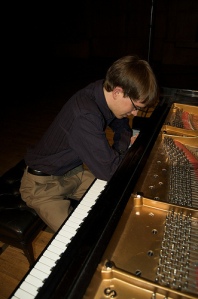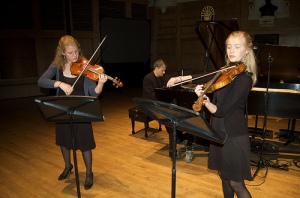Show 215: Listening Guide
This week’s From the Top broadcast was taped at Merrill Auditorium in Portland, Maine on March 24, 2010. We asked our performers to tell us about the music they performed on the show:
Wilson (Will) Bristol, 17, piano
IV. Toccata from Sonata No. 1, Op. 25 by Dianne Goolkasian Rahbee
Dianne Rahbee’s Toccata from her Sonata No. 1 is a very satisfying piece to play. It’s not a controlled, refined piece, but rather a wild and crazy outpouring of emotion. This is the most appropriate piece I’ve ever come across for letting out anger. You get to let your anger out on the piano in the same way some people let out frustration on a punching bag. It’s really fun to shock the audience at the beginning by pounding on the piano with your arms. This is the only piece I’ve ever played where it’s permissible to use your arms. It’s a relentless, all-out expression of frustration with the world. I think this piece is more about the general effect and emotion than the details.
Clark Pang, 14, cello
II. Adagio from Cello Sonata, Op. 6 by Samuel Barber
The beginning of this piece, with its rich and flowing melody, makes me think of rolling hills and clear blue skies. Then, in complete contrast, the picture I see in my mind switches to an urban, black-and-white video clip of crowds of people speed-walking down a busy street in the Roaring Twenties. This is the middle of the piece, which is fast, lively, and vigorous. Finally, the piece relapses back to an echo of the beginning. There is so much beauty and emotion within this piece that is waiting to be unlocked and released.
Anna Lucia DeLoi, 14, harp
Valse by Arnold Bax
I love this piece! It’s unexpected, dramatic, and a little bit creepy, which makes it exciting to play (and hopefully to listen to)! Although the opening waltz is gracious and charming, listeners soon begin to realize that there is more to the piece than a sugar-sweet dance. It grows increasingly hysterical, and the harmonies become dissonant. By the time the original melody returns, it is crazed and deformed. I like to think of a horror movie while I play it – the kind with a beautiful, possessed doll. She is perfectly lovely, in a little white lace dress, but when the toy store closes at night, her eyes turn red and she ravages the streets of the town. A bit morbid, I admit, but it fits the piece. It certainly isn’t the classic “pretty harp piece”! There is nothing conventional about it.
Josie Davis, 18, violin (Davis Duo)
II. Largo ma non tanto from Concerto in D minor, BWV 1043 “Double Concerto” by Johann Sebastian Bach
The “Largo” movement is undoubtedly my favorite movement of the concerto. I love how the beautiful secondary line supports the melody, which passes between the two violins. When I play this particular movement, I imagine complete serenity – like glassy water, so still it is able to reflect images in crystalline detail.
My goal when I play the Bach Double is to articulate each musical idea so that the movement’s simple beauty can be understood by the listener. The harmonies are pleasing to the ear, so unlike some pieces I play, my job is not to convince listeners that the music is actually beautiful. I want to bring my own spirit and life into what has become a well-known piece of music. I hope to create an interpretation that sounds innovative and unique, but that still captures the spirit of Bach. This is the most challenging part about playing such legendary music.
Sophie Davis, 15, violin (Davis Duo)
II. Largo ma non tanto from Concerto in D minor, BWV 1043 “Double Concerto” by Johann Sebastian Bach
The “Largo” movement from Bach’s Double Concerto is one of my favorite pieces to play. I am fascinated by Bach’s ability to develop one melody and pass it seamlessly between the two violins. The concerto is not technically difficult to play; however, creating a well-phrased and unique interpretation is difficult. There are many repeated passages, and I love the challenge of using two instruments to bring out the nuances within these passages. One image that I often correlate with the piece is something flying very high up in the air and looking down, like an aerial snapshot of a majestic landscape.
Playing this piece brings back many memories because it was one of the first pieces my sister and I played together. We spent many Saturdays sitting in the kitchen learning the music.
Acadia Kocher, 16, trumpet (Trumpet Trio and PYSO Ensemble)
Chiapanecas by Traditional Arr. Rafael Mendez
Chiapanecas is just plain happy music. It’s not classical music, which I’m used to playing. It requires you to be a little over-the-top or goofy to get the right effect.
The best run-throughs happen when all three of us get in the right attitude to play it.
Dominic Favia, 16, trumpet (Trumpet Trio and PYSO Ensemble)
Chiapanecas by Traditional Arr. Rafael Mendez
Chiapanecas is a short, fun piece to play. It feels like a party! Mostly we work on etudes and other serious classical pieces that require a refined ear, but the Mendez can be appreciated by anyone, and it gives us lots of freedom do what we like while playing it.
Michael Harper, 17, trumpet (Trumpet Trio and PYSO Ensemble)
Chiapanecas by Traditional Arr. Rafael Mendez
One afternoon, while practicing the piece at my house, our trio seemed a bit loud inside, so we went out on my back patio and set up. It sounded great, except one of my neighbors apparently didn’t think so and called the police. The police officers thought it sounded pretty great! (But we went inside).





